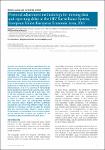Potential adjustment methodology for missing data and reporting delay in the HIV Surveillance System, European Union/European Economic Area, 2015
Rosinska, Magdalena
Pantazis, Nikos
Janiec, Janusz
Pharris, Anastasia
Amato-Gauci, Andrew J.
Quinten, Chantal
ECDC HIV/AIDS Surveillance Network
HIV remains one of the most important public health concerns in the European Union and European Economic Area (EU/EEA). Accurate data are therefore crucial to appropriately direct and evaluate public health response.
The European Centre for Disease Prevention and Control (ECDC) and the World Health Organization Regional Office for Europe (WHO/Europe) have jointly coordinated enhanced HIV/AIDS surveillance in the European Region since 2008. The general objectives of the surveillance system in EU/EEA countries include monitoring of trends over time and across countries. Specific HIV-related objectives include the monitoring of testing patterns, late HIV diagnoses, defined by low CD4+ counts (<350 cells/mm3), and mortality, as well estimating HIV incidence and prevalence stratified by key populations, e.g. transmission category and migrant status [1].
To meet these objectives, the long-term strategy states that improving the quality of surveillance data is needed [2]. Achieving this in practice poses challenges, especially given the heterogeneous national surveillance systems in the EU/EEA and that the routinely collected data are known to suffer from important quality limitations. The limitations originating from national data collection systems may include under-reporting or duplication of cases, delays in reporting, incompleteness of data and misclassification. Accounting for some of these limitations (e.g. assessment of under-reporting) requires additional data such as cohort studies or registries, while other issues, such as incompleteness and reporting delay, may be addressed directly within the surveillance datasets.
Missing data are a well-recognised problem within surveillance systems. When values for some variables are missing and cases with missing values are excluded from analysis, it may lead to biased and potentially less precise estimates [3,4]. In principle, whenever there are missing data or reporting delays, the accuracy of epidemiological distributions and trends should be interpreted with caution.
Reporting delay, the time from case diagnosis to notification, can lead to problems when analysing the most recent years, given that the information on some cases or variables may not have been collected yet because of national reporting process characteristics. This phenomenon is common in disease surveillance and also applies to HIV [5-8]. Rough adjustments for reporting delay were already implemented in the past in Europe [8,9], but further refinement of the existing applied methodology is needed to address this issue across more countries’ data.
The main purpose of this paper is to explore the issues of missing data and reporting delay in EU/EEA HIV surveillance data. We aim to quantify the extent to which these problems are present and to identify specific data characteristics that are relevant for data adjustments. Taking these characteristics into account, we also propose methods to adjust for missing data and reporting delay based on literature and existing national practices in EU/EEA countries.
Dateien zu dieser Publikation

